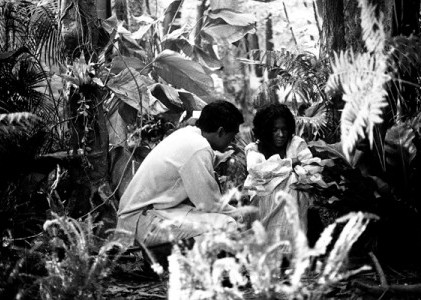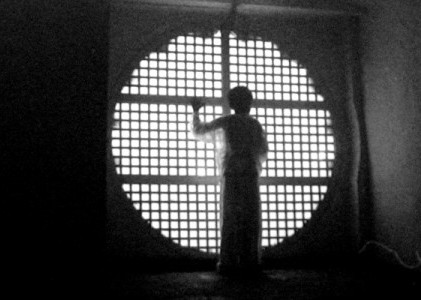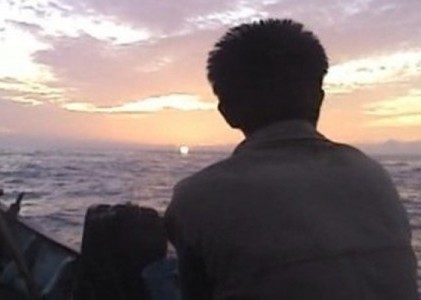The First Impulse
"The first impulse is always one of love." —Alexis Tioseco
It is occasionally impossible to begin things in any way but the wrong one.
I never knew Alexis Tioseco and Nika Bohinc. At the time of their murder I knew nothing of Nika's work (I still know too little), only a bit of Alexis's—I believe I'd read "The Letter I Would Love to Read to You in Person," though perhaps not, that may have come later too. (About it, I'll only say that I'm in full agreement with Gabe Klinger in the belief that it's "a canonical piece of critical writing.") In the wave of remembrances that came in from around the world following their deaths, I saw in them the full expression of ideas about cinema, and about life, that I had only vague impressions of at the time. Over these three years, and I hope you'll forgive me for being somewhat presumptuous, a sadness has grown in me for these two friends I'll never have. In idle moments sometimes I find myself thinking about them, wondering what their days were like, how they handled not only the torrent of love between them, but also their tremendous love for cinema, whether or not they watched silly television shows on the couch at night. And the terror of those last minutes, seconds, together. Would this week, on the happy occasion of the first New York retrospective for Raya Martin, a director Alexis championed before nearly anyone else, have been the first time I would have met them?
A love for what is eternally unknown seems about as good a working definition of the cinema as I can figure, so with that, Alexis, Nika, I love you both.

Independencia
"You don't need to see films to love cinema." —Leos Carax
It's awfully easy, as an American, to take history for granted. Our young country seems to have just enough of it that what's there in the official version feels full: the calendar has plenty of holidays; the schoolbooks have plenty of dates; we have a whole television station just for it. This luxury, which also happens to be the luxury of having been on the receiving end of oppression for only the briefest time, means that certain events—say, the Philippine-American War (1899–1902)—can casually be forgotten when they don't assimilate neatly into a narrative of valor and general moral good.
This tendency to cherry-pick the history we'd like sidles up alongside another great American tradition: the movies. Whether or not you buy the Deleuzo-Godardian notion of Hollywood as a factory cranking out an imperialist army of histories to cover its, and our, own lack of one, this process has congealed to the point that Hollywood now does have some kind of history, one that's also full enough to allow its present to pick and choose its continuities. For multinational corporate-industrialist Hollywood, this means that stories and resolution are in, and the mysterious complexity of the world is out. Go to any major film school in this country and you'll hear the same bromides about "connecting with audiences" alternating with praise for the relentless forward march of technology, ever smaller, ever cheaper. The platonic ideal here is a film that costs nothing and wins over audiences so thoroughly that they simply can't resist giving it every last cent in their bank accounts. The history of cinema exists only as an object defined in negative; young filmmakers should watch Griffith to find a few parts to improve upon, and the rest can be cast away as obsolete.

A Short Film About the Indio Nacional
Raya Martin is one of cinema's great hopes against this blind movement forward. In the eight years since he began his career, he's made nearly 20 films of a wide variety of lengths and styles, united only by a consistent concern with diving, stumbling, or running back into the past. Against the usual approach of looking back for either narrative forms or just simply narratives (i.e., the full being of history reduced to stories that can be retold; this is generally the American way), Martin's films engage the past creatively, finding in it spaces still waiting to be filled. When he made a silent film (A Short Film About the Indio Nacional) in 2006—one completely free of gimmicks, that feels no need to acknowledge, let alone apologize for, what it is—he did something quite astonishing. He created a historical film that simultaneously occupies two positions 110 years apart, one looking back from 2006, the other looking forward from the Philippine Revolution of 1896. In a country where little of its earliest cinema survives (the Philippines finally began a national film archive only last year), Indio Nacional reconstitutes a history that has been lost, or perhaps never was. Although the allegorical story of a boy, an old man, and a heavy burden offered by the contemporary prologue, shot in color digital video in contrast to the silent footage's black-and-white 35mm, offers something of a framework, the film functions not as a conduit for the transmission of narrative knowledge, but simply confirms events, bodies, desires.
This sense that cinema is, after Rivette, not a language after all—its true use is in showing the unity of the world, not in analyzing it—informs Martin's work from the beginning. The Island at the End of the World, his first feature, explores Itbayat, a secluded island in the north of the Philippines, with great thoroughness but never moves beyond the initial impulse of curiosity to offer any facet of the island as an argument about the world. Itbayat and its people are shown as they are, building boats, working in fields and libraries, fishing, etc. What is communicated by these images? Nothing, I would argue, more or less than the impulse of love, a genuine desire to explore that which is unknown, shot through with a humble understanding that the only way to really know these lives is to live them. If we can accept this thoughtful desire as the heart of the cinema, then of course you don't need to watch films to love cinema.
Up against the many, many films that are totally devoid of cinema-image after image with nothing there—each of Martin's films stakes this perspective on its topic. In the opaque historical drama Autohystoria the murder of two Filipino rebels is refigured as an experience in duration and looking, attentiveness to urban spaces linked to attentiveness to history. Independencia recreates another lost period, the early, artificial talking adventure film, exploring the process of combining popular filmmaking with revolutionary messages. In these films—and in Buenos Noches, España's infinite, recursive loop of love in space and out of time—there is a commitment to exploring something fundamentally impossible to fully know without betraying that impossibility in the slightest. This tendency in Martin's filmmaking reaches a new peak with this year's The Great Cinema Party, a 70-minute feature made as part of the Jeonju Film Festival's Digital Project.
Awarded $50,000 and carte blanche beyond the requirement of shooting on digital video, Martin created what on first look seems to be his simplest film since his debut, an uneven diptych composed of a collage and a sort of low-key hang-out documentary. This relatively straightforward presentation turns out to mask a conceptual framework as rigorous and inventive as anything in his career, an attempt at synthesizing Rivette's disavowal of cinema as a language with Bazin's assertion of it as such. (When Lav Diaz pops up at the junction between the film's two parts to invite us to The Great Cinema Party—which, n.b., is literally a party, with guests including filmmakers Brillante Mendoza and John Torres and critics Mark Peranson and Antoine Thirion wandering an island on Manila Bay before settling down for a cookout—the two guests mentioned by name are Bazin and Andrei Tarkovsky.) That is, The Great Cinema Party is an attempt to figure out in 70 minutes where exactly the limits of cinema sit, and just what we might mean when we say that it is or isn't a language.

The Island at the End of the World
In a perceptive article on the film for Cinema Scope, Michael Sicinski has traced a line that connects its two halves via their relations to conflict, and followed this to pose two basic questions: Does the appositeness of the motion picture for showing images of war make wars in some way a continual source of "worthy profilmic events"? And might images of boredom, or pleasure (these being taken as more or less synonymous with images of boredom in traditional filmmaking), such as those in The Great Cinema Party, serve as the greatest source of resistance in this filmic economy? I am inclined to answer yes to both questions, and to believe that this alone makes GCP one of the genuinely important films of the year, but I also believe it can be followed to a more basic understanding of human engagement with the world, one that subtends even the ideas regarding conflict that Sicinski maps so well.
I was slightly inaccurate in describing the film as a diptych above—in fact the second half itself divides in two, the lengthy segment following the guests as they explore the island and enjoy the cookout giving way to nearly 20 minutes of pure black accompanied by "The Great Cinema Overture," a piece of triumphant post-rock (think Godspeed You! Black Emperor) that constitutes probably the only example of this type of music actually being used well in a film. In these three segments—images of war, images of pleasure, absence of the image—we're offered three different opportunities to consider what is, or isn't, being communicated.
The opening montage, with its images of war first cropped down to widescreen to match the Scope aspect ratio of the original footage and then subjected to various other manipulations, including being slowed down, reversed, and turned to negatives, recalls more than slightly the recent collage work of Jean-Luc Godard. But where Godard's collisions inevitably result in wreckage that points elsewhere (this is, after all, the man whose greatest work bears the title Histoire(s)), Martin presents his troops and bombers and boats and ruins as objects free of context, studies in geometry and movement testifying to the fact that these things happened while refusing to offer any further explanation. Individually, and in concert, they prove as terribly, viscerally captivating as they are inadequate: what can these tell about the horror that we're seeing other than confirming that it existed, placing it as a historical fact? In this light, it's only logical that we have still never seen any footage shot inside the concentration camps. It's impossible to reduce six million deaths to a historical fact—the cinema, when it runs up against what it cannot hope to express, has the good sense to let that absence speak for itself.
The second segment, in following the partygoers as they talk and laugh and experience this new place, counterbalances the opening, scaling global catastrophe down to personal communication. Here, the fact of just being seems adequate; history functions at a scale that allows for an expression closer to the reality of the situation. What's here, as in The Island at the End of the World, cannot truly be known, but the information that might be taken from such a cinematic engagement communicates more than any mass image of war because it's not beholden to any inevitably obfuscating global narrative. Martin and his cinematographer Gym Lumbera (the duo have recently completed an installation piece that will be on display at the Museum during the retrospective) have found an ideal visual representation of this mixture of clarity and uncertainty: shooting with an old anamorphic widescreen lens on a digital camera, every image captures the objects at its center with great clarity while still pointing toward the hazy, distorted expanse at the edges of each frame.
The darkness that closes the film resolves the prior two segments: the importance of cinema's inability to truly capture an image of war and its ability to express something of the mystery of the everyday mesh in the darkness, the image conceding its representational inadequacy to transmit something ineffable, the uncertainty of being alone with ourselves and our senses, but surrounded by others experiencing the same feeling, that the cinema alone can offer us. The soundtrack's triumphant crescendos are no less manipulative here than they are in guiding us toward the emotion of athletic thrills in Friday Night Lights. But the difference is that they're celebrating our own acknowledgment of sensing the world, of feeling the dark with our eyes and knowing how many things are out there waiting for us to find them, not through a cinema screen (which might serve as a good starting point yet won't ever go further) but through our own impulse of love, this desire to know all those things that are unknowable.
I'd like to end with what is not at all a rhetorical question: How can cinema be dying, or dead, when one of the great directors in the world hasn't even hit 30 yet? ![]()
LATEST ARTICLES
-20140814-173707-thumb3.jpg)
Fighting Words
by Imogen Sara Smith
posted August 12, 2014

Fighting Words, Part 2
by Imogen Sara Smith
posted August 20, 2014

On the Margins: The Fil…
by Andrew Chan
posted August 12, 2014

Robin Williams: A Sense…
by David Schwartz
posted August 12, 2014
 The First Impulse
The First Impulse
THE AUTHOR
Phil Coldiron is a writer and programmer living in Brooklyn.
More articles by Phil Coldiron
